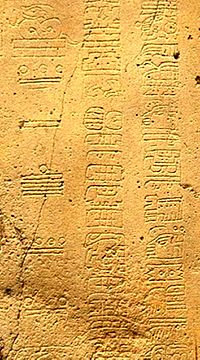Isthmian script facts for kids
Quick facts for kids Isthmian script |
|
|---|---|

Detail showing three columns of glyphs from La Mojarra Stela 1. The two right columns are Isthmian glyphs. The left column gives a Mesoamerican Long Count calendar date of 8.5.16.9.7, or 156 CE.
|
|
| Type | Undeciphered (assumed to be logo-syllabic) |
| Spoken languages | Epi-Olmec (ISO639-3:xep) |
| Time period | Perhaps ca. 500 BCE to ca. 500 CE |
| Note: This page may contain IPA phonetic symbols in Unicode. | |
The Isthmian script is a very old Mesoamerican writing system. It was used in the area of the Isthmus of Tehuantepec in what is now Mexico. People likely used it from about 500 BCE (Before Common Era) to 500 CE (Common Era). However, experts still discuss these exact dates.
This script is also known by other names. These include the La Mojarra script and the Epi-Olmec script. 'Epi-Olmec' means 'post-Olmec' or 'after the Olmecs'.
The Isthmian script is similar to the Maya script. Both systems use two main types of characters. One type represents logograms, which are like whole words or ideas. The second type represents syllables, which are parts of words.
Where We Found Isthmian Texts
Experts have found the Isthmian script on several important objects. These objects help us learn about this ancient writing.
The four longest and most important Isthmian texts were found on:
- The La Mojarra Stela 1: A large stone slab with many carvings.
- The Tuxtla Statuette: A small, carved stone figure.
- Tres Zapotes Stela C: Another carved stone monument.
- A mask made in the style of Teotihuacán.
Other places where Isthmian script has been found include:
- A few glyphs on four old stelae (stone monuments) at Cerro de las Mesas. These are stelae 5, 6, 8, and probably 15.
- About 23 glyphs on a clay object called the O'Boyle "mask." We don't know exactly where this object came from.
- A small number of glyphs on a piece of pottery from Chiapa de Corzo. This pottery piece has the oldest date of any Isthmian script artifact. It is from 450-300 BCE.
Trying to Understand the Script
When a writing system is "undeciphered," it means we don't know how to read it. Many experts have tried to decipher the Isthmian script.
In 1993, two researchers, John Justeson and Terrence Kaufman, suggested they had partly deciphered the Isthmian text on the La Mojarra Stela. They believed the language was part of the Zoquean language family. They published more findings in 1997. Their work was recognized with a special award in 2003.
However, other experts disagreed with their findings. In 2004, Stephen D. Houston and Michael D. Coe tried to use Justeson and Kaufman's system to read the Isthmian text on the Teotihuacan-style mask. They were not successful.
So, the mystery of the Isthmian script is still being discussed. As expert Andrew Robinson wrote in 2008, the idea that the script has been deciphered is "unproven." He said that to truly understand it, we need to find new texts that are as long and detailed as the one on the La Mojarra Stela.
See also
 In Spanish: Escritura epiolmeca para niños
In Spanish: Escritura epiolmeca para niños

